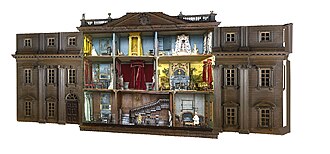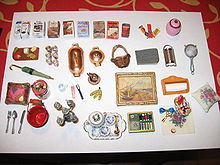Dollhouse
The history of today's dollhouses can be traced back about four hundred years to the baby house display cases of Europe, which showed idealized interiors.Early dollhouses were all handmade, but following the Industrial Revolution and World War II, they were increasingly mass-produced and became more standardized and affordable.Miniature homes, furnished with domestic articles and resident inhabitants, both people and animals, have been made for thousands of years.The earliest known European dollhouses were the baby houses from the 16th century, which consisted of cabinet display cases made up of individual rooms.The cabinets were built by hand with architectural details, filled with miniature household items and were solely intended for adults.With the advent of the Industrial Revolution, factories began mass producing toys, including dollhouses and miniatures suitable for furnishing them.The list of important English companies includes Silber & Fleming, Evans & Cartwright, and Lines Brothers (which became Tri-ang).The TynieToy Company of Providence, Rhode Island, made authentic replicas of American antique houses and furniture in a uniform scale beginning in about 1917.Such houses cost little enough that the great majority of girls from the developed western countries which were not struggling with rebuilding after World War II could own one.Common brands include Lundby (Sweden), Renwal, Plasco, Marx, Petite Princess, and T. Cohn (all American) and Caroline's Home, Barton, Dol-Toi and Tri-ang (English).The largest common size for dollhouses is 1:6 which is proportionate for Barbie, Ken, Blythe and other dolls 11-12 inches tall, and furniture and accessories such as Re-Ment.Children's dollhouses during the 20th century have been made from a variety of materials, including metal (tin litho), fibreboard, plastic, and wood.Recognition of the value and enjoyment of collecting vintage and antique dolls houses as a hobby is due largely to the publications of two experts, Vivien Greene (1904-2003) in the UK, and Flora Gill Jacobs (1918-2006) in the US.Through print publications such as the International Dolls' House News (c 1969-2002) American Miniaturist, and Dolls House and Miniature Scene, collectors around the world shared photos, tips, queries and information; today, websites, blogs, social media, and online forums allow even more collectors to share their hobby.Writers like Sir Arthur Conan Doyle and Rudyard Kipling contributed special books which were written and bound in scale size.It required 10 years to build, is 4'6" in height, contains 22 rooms, and was built by Ron McDonnell beginning in 1978 after he failed to secure the return of Titania's Palace to Ireland.Many contemporary artists made miniatures of their art for the dollhouse, including Marcel Duchamp, Alexander Archipenko, George Bellows, Gaston Lachaise, and Marguerite Zorach.[31][32] The Astolat Dollhouse Castle was inspired by Alfred Tennyson's poetry about the Lady of the Lake and built between 1974 and 1987 by miniaturist Elaine Diehl.









Dollhouse (disambiguation)miniatureUnited KingdomIndustrial RevolutionWorld War IImass-producedEgyptian tombsOld KingdomNuremberg, GermanyPetronella de la CourtCentraal MuseumAlbrecht V, Duke of BavariaNuremberg kitchensDorotheaAugustus, Elector of SaxonyElastolinLines BrothersWorld War IMärklinTootsietoysheet metalLundbyTri-angthe metric systemBarbieBlytheRe-Menttin lithoplywoodmedium-density fiberboardfurnitureinterior decorationsclocksminiature foodVivien GreeneOxfordWashington D.C.Sara RothécabinetFrans Hals MuseumGemeentemuseum Den HaagPetronella OortmanRijksmuseum AmsterdamguildersTampereFinlandMoomin MuseumMoominTove JanssonDollhouse MuseumGermanNational Pushkin MuseumUpparkNostell PrioryMuseum of ChildhoodLondon, EnglandQueen Mary's Dolls' HouseQueen MaryEdwin LutyensWindsor CastleSir Arthur Conan DoyleRudyard KiplingTitania's PalaceEgeskov CastleDenmarkNeville WilkinsonIrelandTara's Palace Museum of ChildhoodPowerscourt EstateEnniskerryStettheimer DollhouseMarcel DuchampAlexander ArchipenkoGeorge BellowsGaston LachaiseMarguerite ZorachThorne Roomsroom boxesNarcissa Niblack ThorneArt Institute of ChicagoPhoenix Art MuseumKnoxville Museum of ArtAstolat Dollhouse CastleMuseum of Science and IndustryChicago, IllinoisAlfred TennysonLady of the LakeNassau County Museum of ArtNurembergBeatrix PotterThe Tale of Two Bad MiceMauritaniaSwedishAmy CarterWhite HousePlaymobilMini BrandsOxford English DictionaryOxford University PressWayback MachineV&A Museum of ChildhoodUniversity of Nebraska–LincolnScale modellingAircraftArchitecturalConstructionDioramaFigureActionMilitaryRocketRailwayWargamingDiecastMatchstickPlasticStandard gauge railway scalesT gaugeZ scaleN scaleTT scaleHO scaleOO scaleProtofourS scaleG scale